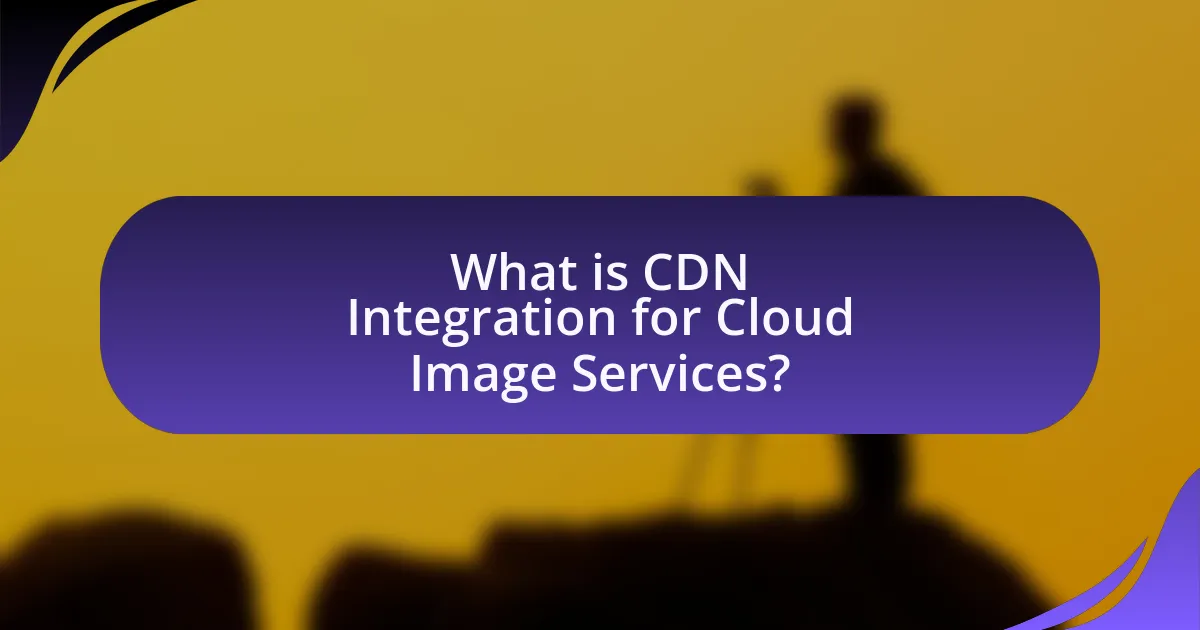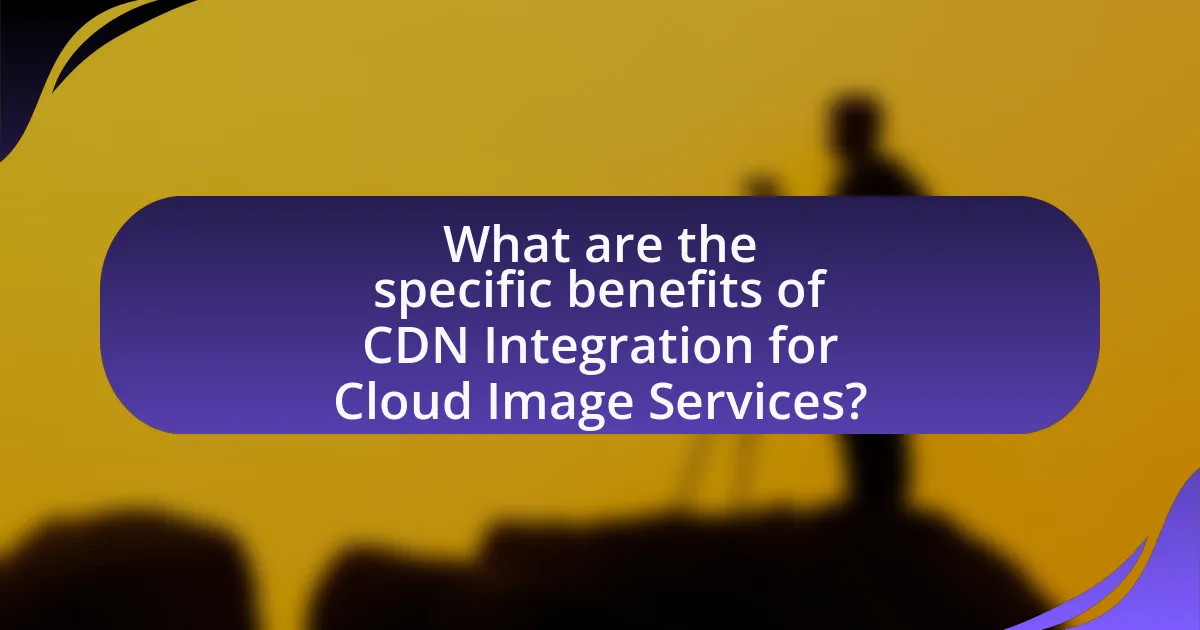CDN integration for cloud image services involves the use of a Content Delivery Network to enhance the delivery and performance of images stored in cloud environments. This integration significantly reduces latency and improves load times by distributing content across multiple geographically dispersed servers, with studies indicating potential load time reductions of up to 50%. Key benefits include enhanced speed, reliability, scalability, and cost savings, as well as improved user experience through faster image loading and reduced bandwidth costs. The article will explore the importance of CDN integration, the challenges faced without it, and best practices for implementation, providing a comprehensive understanding of its impact on cloud image services.
What is CDN Integration for Cloud Image Services?

CDN integration for cloud image services refers to the incorporation of a Content Delivery Network (CDN) to optimize the delivery and performance of images stored in cloud services. This integration enhances the speed and reliability of image loading by distributing content across multiple geographically dispersed servers, reducing latency and improving user experience. Studies show that using a CDN can decrease load times by up to 50%, significantly benefiting websites and applications that rely heavily on image content.
How does CDN Integration enhance cloud image services?
CDN integration enhances cloud image services by improving content delivery speed and reliability. By distributing images across multiple servers globally, a CDN reduces latency, ensuring that users access images from the nearest server, which significantly decreases load times. For instance, studies show that using a CDN can reduce image load times by up to 50%, leading to better user experiences and increased engagement. Additionally, CDNs provide scalability during traffic spikes, ensuring consistent performance even under heavy loads, which is crucial for cloud image services that may experience variable demand.
What are the key features of CDN integration?
The key features of CDN integration include improved content delivery speed, enhanced reliability, and scalability. CDNs achieve faster content delivery by caching content at multiple edge locations, reducing latency for users by serving data from the nearest server. Enhanced reliability is provided through load balancing and redundancy, ensuring that content remains accessible even during high traffic or server failures. Scalability allows businesses to handle increased traffic without compromising performance, as CDNs can dynamically allocate resources based on demand. These features collectively optimize the user experience and support the efficient distribution of cloud image services.
How does CDN integration improve image delivery speed?
CDN integration improves image delivery speed by distributing content across multiple geographically dispersed servers, allowing users to access images from the nearest server location. This reduces latency and minimizes the time it takes for images to load, as data travels shorter distances. According to a study by Akamai, using a CDN can reduce load times by up to 50%, significantly enhancing user experience and engagement.
Why is CDN Integration important for cloud image services?
CDN integration is important for cloud image services because it enhances the speed and reliability of image delivery. By distributing images across multiple servers located in various geographic locations, CDNs reduce latency and ensure faster load times for users, regardless of their location. Studies show that websites utilizing CDNs can achieve load time improvements of up to 50%, significantly enhancing user experience and engagement. Additionally, CDNs provide scalability and redundancy, allowing cloud image services to handle high traffic volumes without compromising performance, which is crucial for businesses that rely on visual content.
What challenges do cloud image services face without CDN integration?
Cloud image services face significant challenges without CDN integration, primarily including increased latency and reduced performance. Without a Content Delivery Network, images must be fetched from a centralized server, which can lead to slower load times, especially for users located far from the server’s geographic location. This latency can negatively impact user experience and engagement, as studies show that a one-second delay in page load time can lead to a 7% reduction in conversions. Additionally, without CDN support, cloud image services may struggle with scalability during traffic spikes, resulting in potential downtime or degraded service quality. This lack of redundancy and load balancing can further exacerbate performance issues, making it difficult for cloud image services to maintain reliability and speed.
How does CDN integration address these challenges?
CDN integration addresses challenges in cloud image services by enhancing content delivery speed and reliability. By distributing content across multiple geographically dispersed servers, CDNs reduce latency and ensure faster load times for users, regardless of their location. This is particularly important for image-heavy applications, where delays can lead to poor user experiences. Additionally, CDNs provide load balancing and redundancy, which mitigate the risk of server overload and downtime. According to a study by Akamai, implementing a CDN can improve website performance by up to 50%, demonstrating its effectiveness in overcoming these challenges.
What are the specific benefits of CDN Integration for Cloud Image Services?

CDN integration for cloud image services provides enhanced performance, scalability, and reliability. By distributing content across multiple servers globally, CDNs reduce latency, ensuring faster image loading times for users regardless of their geographic location. This is particularly beneficial for websites with high traffic, as CDNs can handle large volumes of requests efficiently. Additionally, CDNs offer improved security features, such as DDoS protection and secure token authentication, which safeguard image assets from unauthorized access and attacks. Furthermore, the use of CDNs can lead to cost savings by optimizing bandwidth usage and reducing the load on origin servers, as evidenced by studies showing that CDN usage can decrease bandwidth costs by up to 50%.
How does CDN Integration improve user experience?
CDN integration improves user experience by reducing latency and increasing content delivery speed. By distributing content across multiple geographically dispersed servers, CDNs ensure that users access data from the nearest server, minimizing the time it takes for web pages and images to load. Studies show that faster load times can lead to higher user satisfaction, with a 1-second delay potentially decreasing page views by 11% and increasing bounce rates by 32%. This efficiency not only enhances user engagement but also supports better performance during high traffic periods, ensuring consistent access to content.
What role does latency play in user experience?
Latency significantly impacts user experience by affecting the speed at which content is delivered to users. High latency can lead to delays in loading times, resulting in frustration and decreased user satisfaction. Studies show that a one-second delay in page load time can lead to a 7% reduction in conversions, highlighting the critical nature of low latency in maintaining user engagement and satisfaction. Additionally, users expect real-time interactions; thus, minimizing latency is essential for applications like streaming and gaming, where delays can disrupt the experience.
How does CDN integration reduce load times for images?
CDN integration reduces load times for images by distributing content across multiple geographically dispersed servers. This distribution allows users to access images from a server that is physically closer to them, minimizing latency and improving loading speed. For instance, studies have shown that using a CDN can decrease load times by up to 50% compared to serving images from a single origin server, as the CDN caches images and serves them from the nearest location, optimizing the delivery process.
What cost benefits does CDN Integration provide?
CDN integration provides significant cost benefits by reducing bandwidth costs and improving resource efficiency. By caching content closer to users, CDNs minimize the amount of data that needs to be transmitted over long distances, which directly lowers bandwidth expenses for businesses. Additionally, CDNs can handle large volumes of traffic without requiring companies to invest in additional infrastructure, thus optimizing operational costs. According to a study by CDNetworks, businesses can save up to 50% on bandwidth costs when utilizing CDN services, demonstrating the financial advantages of this integration.
How can CDN integration reduce bandwidth costs?
CDN integration can reduce bandwidth costs by caching content closer to users, which minimizes the distance data must travel. This proximity decreases the amount of data that needs to be transmitted over long distances, effectively lowering the overall bandwidth consumption. For instance, a study by Akamai found that using a CDN can reduce bandwidth costs by up to 50% for high-traffic websites, as the CDN serves cached content instead of the origin server. This not only optimizes data delivery but also alleviates the load on the origin server, further contributing to cost savings.
What are the long-term financial advantages of using CDN integration?
The long-term financial advantages of using CDN integration include reduced bandwidth costs and improved website performance, which can lead to higher conversion rates. By distributing content across multiple servers, CDNs minimize the amount of data that needs to be transferred from the origin server, thereby lowering bandwidth expenses. Additionally, faster load times enhance user experience, resulting in increased customer retention and sales. Research indicates that a one-second delay in page load time can decrease conversions by 7%, highlighting the financial impact of improved performance through CDN integration.
What are the best practices for implementing CDN Integration in Cloud Image Services?

The best practices for implementing CDN integration in cloud image services include selecting a reliable CDN provider, optimizing image formats and sizes, configuring caching policies effectively, and ensuring secure content delivery. A reliable CDN provider enhances performance and availability, while optimizing image formats like WebP can reduce load times significantly. Effective caching policies, such as setting appropriate cache expiration headers, improve efficiency by minimizing server requests. Additionally, using HTTPS ensures secure delivery of images, protecting user data and enhancing trust. These practices collectively contribute to improved performance and user experience in cloud image services.
How can businesses choose the right CDN provider?
Businesses can choose the right CDN provider by evaluating key factors such as performance, geographic coverage, security features, and pricing models. Performance is critical; a CDN should offer low latency and high availability, which can be assessed through benchmarks and user reviews. Geographic coverage ensures that the CDN has a presence in regions where the business’s audience is located, enhancing content delivery speed. Security features, including DDoS protection and SSL support, are essential to safeguard data and maintain user trust. Finally, pricing models should align with the business’s budget and usage patterns, allowing for scalability as needs grow. These criteria help businesses select a CDN provider that meets their specific requirements effectively.
What factors should be considered when selecting a CDN provider?
When selecting a CDN provider, key factors include performance, reliability, geographic coverage, security features, and cost. Performance is crucial as it affects load times and user experience; a CDN with a robust infrastructure can significantly reduce latency. Reliability is essential to ensure consistent uptime and service availability, which can be assessed through SLAs and historical performance data. Geographic coverage matters because a provider with a wide network of edge servers can deliver content more efficiently to users across different regions. Security features, such as DDoS protection and SSL support, are vital to safeguard data and maintain user trust. Lastly, cost should be evaluated in relation to the features offered, ensuring that the selected provider aligns with budget constraints while meeting performance and security needs.
How do different CDN providers compare in terms of performance?
Different CDN providers vary significantly in performance, with key metrics including latency, throughput, and reliability. For instance, Akamai is often recognized for its extensive global network, resulting in lower latency and higher throughput for users across diverse geographical locations. Cloudflare, on the other hand, excels in speed due to its innovative caching strategies and optimized routing, often achieving faster load times for static content. Amazon CloudFront provides robust integration with AWS services, which can enhance performance for applications hosted on AWS by reducing latency through proximity to the origin server. According to a study by CDN Planet, Akamai consistently ranks at the top for performance metrics, while Cloudflare shows superior performance in specific use cases like DDoS protection and dynamic content delivery. These performance differences are critical for businesses to consider when selecting a CDN provider to meet their specific needs.
What common pitfalls should be avoided during CDN integration?
Common pitfalls to avoid during CDN integration include misconfiguration, inadequate testing, and ignoring caching strategies. Misconfiguration can lead to issues such as incorrect DNS settings or SSL certificate problems, which can disrupt content delivery. Inadequate testing may result in performance bottlenecks or broken links, as not all scenarios are evaluated before going live. Ignoring caching strategies can lead to unnecessary load on the origin server, reducing the effectiveness of the CDN. These pitfalls can significantly impact the performance and reliability of cloud image services, making it essential to address them proactively.
How can misconfiguration affect CDN performance?
Misconfiguration can significantly degrade CDN performance by causing increased latency, reduced availability, and inefficient resource utilization. When settings such as cache control, origin server configuration, or DNS records are incorrectly set, content may not be delivered optimally, leading to slower load times for users. For instance, a study by Akamai found that a 100-millisecond delay in load time can reduce conversion rates by 7%. Additionally, misconfigured security settings can lead to service outages or vulnerabilities, further impacting performance. Therefore, proper configuration is essential for maintaining the efficiency and reliability of CDN services.
What are the best strategies for troubleshooting CDN issues?
The best strategies for troubleshooting CDN issues include checking the CDN provider’s status page, analyzing logs for error messages, and testing connectivity from various locations. Monitoring the CDN’s performance metrics can help identify bottlenecks or latency issues. Additionally, purging the cache can resolve problems related to outdated content delivery. Using tools like traceroute and ping can assist in diagnosing network-related issues. These strategies are effective as they provide a systematic approach to identifying and resolving common CDN problems, ensuring optimal performance and reliability.
What are practical tips for optimizing CDN Integration for Cloud Image Services?
To optimize CDN integration for cloud image services, implement caching strategies effectively. Caching reduces latency by storing frequently accessed images closer to users, which can significantly enhance load times. Additionally, utilize image optimization techniques such as compression and format conversion to decrease file sizes without sacrificing quality, leading to faster delivery through the CDN.
Furthermore, configure CDN settings to enable HTTP/2, which allows multiplexing and reduces the number of connections needed, improving performance. Regularly monitor CDN performance metrics to identify bottlenecks and adjust configurations accordingly. Employing a global CDN provider with a wide network of edge locations ensures that images are served from the nearest point to the user, further enhancing speed and reliability.



